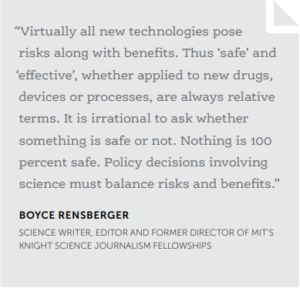It may be tempting to try to put risk in perspective by comparing it to something your audience is familiar with (e.g. road accidents, smoking a pack of cigarettes a day).
But be careful! Translating statistics and risks has pitfalls.
Absolute risk vs. relative risk
Absolute risk refers to the naturally-occurring frequency of an event. It gives an ordinary frame of reference that is easy to understand.
Example: Four out of every 1000 women will die of breast cancer in the next 10 years.
Relative risk refers to a change in the level of risk. This kind of figure often sounds very impressive, and is frequently used in reports of drug trials or new treatments, but it has little meaning unless it is put into the correct context.
Example: This drug reduces a woman’s risk of dying from breast cancer by 25%.
In the example above, the 25% decrease actually means that for every 1000 women taking the drug, three will die of breast cancer instead of four. In other words, this treatment could potentially save one life in 1000.
When the percentage is given in terms of a woman’s overall risk of dying from breast cancer, it means a reduction of 0.1%. This is because the risk of dying from breast cancer is relatively small to begin with, so even a large reduction in that risk does not equate to many lives saved.
One of the most common confusions occurs when these two types of risk are mixed up. Using the context of absolute risk (or getting an expert to provide this) is the best way to explain what a result will mean for your audience in their daily lives.
Positive vs. negative frame
Pay attention to the way statistics are framed. While a 97% chance of survival, and a 3% chance of dying may both be correct, they don’t always mean the same to the person listening.
Evidence shows that positive framing is more effective than negative framing in persuading people to take risky treatment options.
Single event probabilities

The chances of a single, undesirable event taking place can be easily confused with the everyday likelihood of things going wrong.
Example: A psychiatrist prescribes a drug to his patients with the warning that they will have a “30% to 50% chance of developing a sexual problem” such as impotence or loss of sexual interest.
Their patients may understand this to mean 30 to 50% of their own sexual encounters will be problematic, and refuse the drug. But the psychiatrist actually means that of every 10 patients taking the drug, three to five will experience a sexual problem at some stage. Explaining it this way, they find their patients are less concerned about the risk.
Rare exposures
If being exposed to some harmful factor increases your risk a lot, but that harmful exposure is very rare, it may be important for a small number of individuals but cannot have a big impact on the average reader.
Example: Angelina Jolie has a particular genetic variant in the BRCA gene that gives her an 85% lifetime risk of breast cancer.
This is a very high risk, but the genetic variant is rare — only about 1% of women have it — so only a very small fraction of all breast cancer could be prevented by genetic testing.
Reviewed by Professor Thomas Lumley, University of Auckland Te Whare Wānanga o Tāmaki Makaurau statistician and founder of the blog Stats Chat, which aims to help improve statistical literacy by scrutinising facts and figures used in the media and in the world around us.
